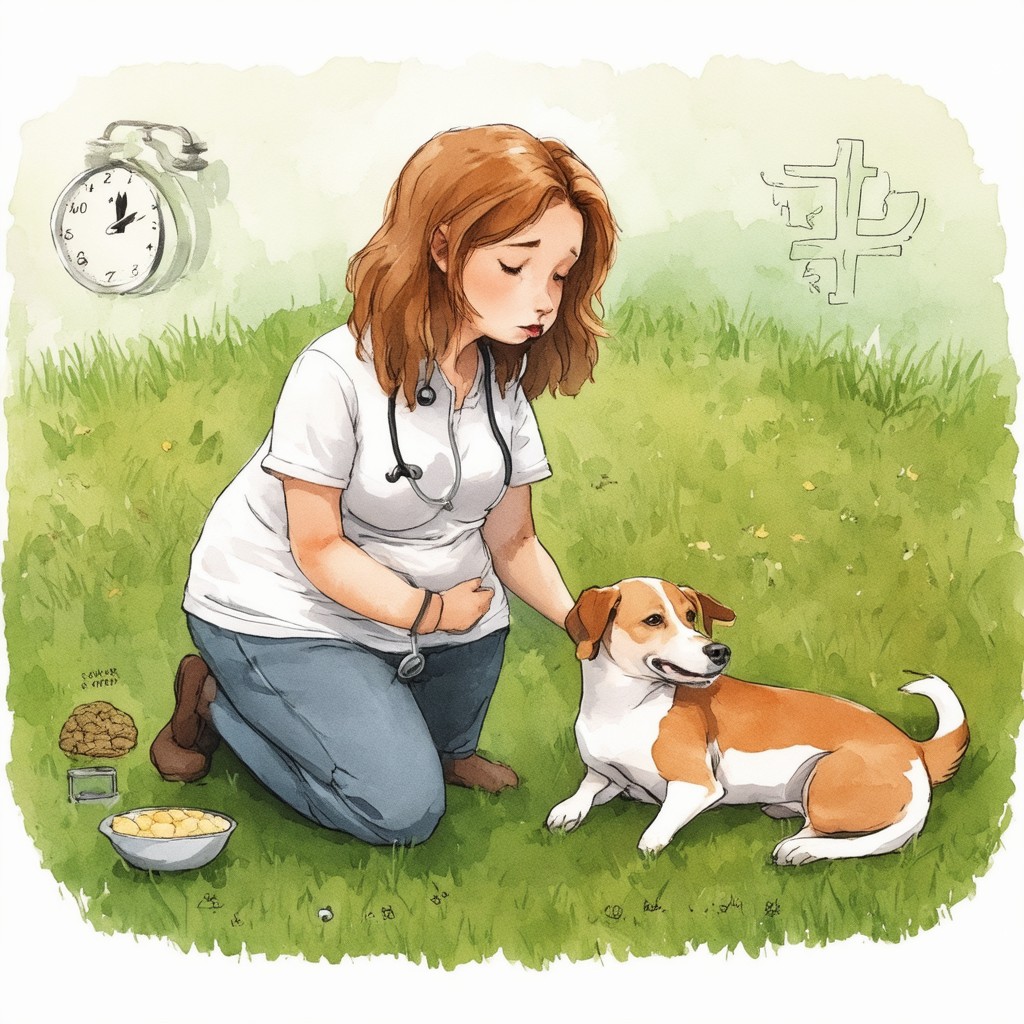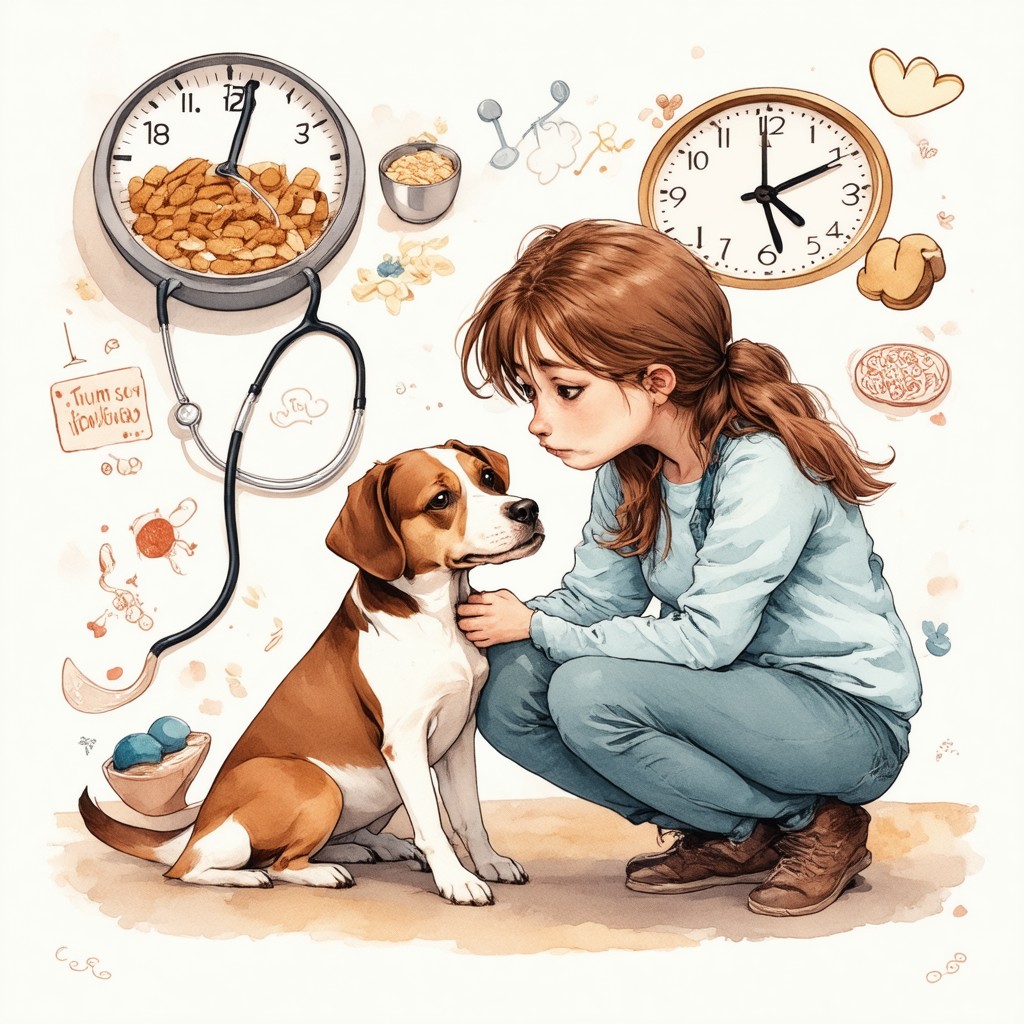Key Takeaways
- Monitor your dog’s vomiting frequency; multiple episodes or persistent vomiting over 24 hours warrant veterinary attention.
- Look for concerning symptoms like blood in vomit, lethargy, or dehydration, which may indicate serious health issues.
- Identify common causes of vomiting, including dietary indiscretion, infections, and gastrointestinal disorders.
- Implement home remedies such as fasting and gradual reintroduction of bland diets to manage mild vomiting cases.
- Recognize that yellow bile vomit often signifies an empty stomach; consult a vet if this occurs frequently.
- Seek immediate veterinary help if your dog shows signs of distress, persistent vomiting, or has ingested a foreign object.
Understanding why your dog keeps throwing up can be a perplexing and concerning issue for pet owners. Vomiting in dogs can stem from a variety of causes, ranging from minor dietary indiscretions to more serious health conditions. In this article, we will explore the key signs to watch for when your dog vomits, common causes of dog vomiting, and effective home remedies to alleviate the situation. Additionally, we will discuss when it is crucial to seek veterinary help, especially if your dog is throwing up yellow bile or white foam. By the end of this guide, you will be equipped with the knowledge to identify potential issues and take appropriate action for your furry friend’s health. Whether you are dealing with a puppy vomiting undigested food or a dog that throws up after eating, understanding these symptoms is vital for ensuring your pet’s well-being.
Understanding Why Your Dog Keeps Throwing Up
As a pet owner, it can be distressing to see your dog throwing up. Understanding the reasons behind this behavior is crucial for ensuring your dog’s health and well-being. Vomiting in dogs can stem from a variety of causes, ranging from minor issues to serious health concerns. By recognizing the signs and knowing when to seek help, you can take proactive steps to address your dog’s vomiting.
When should I be concerned about my dog throwing up?
It’s important to monitor your dog’s vomiting closely. Here are key indicators that should prompt you to seek veterinary attention:
- Continuous or frequent vomiting: If your dog experiences multiple episodes of vomiting in a single day or if vomiting persists for more than 24 hours, this is a cause for concern and warrants veterinary attention.
- Vomiting blood: Presence of red, black, or coffee-ground-like vomit indicates potential internal bleeding and requires immediate veterinary evaluation.
- Other concerning symptoms: Accompanying signs such as lethargy, loss of appetite, diarrhea, fever, dehydration, abdominal pain, or weight loss can indicate a serious underlying condition.
- Bloat: A distended abdomen coupled with difficulty breathing can signal gastric torsion (bloat), a life-threatening emergency that requires immediate veterinary care.
- Suspected foreign body ingestion: If you suspect your dog has ingested a non-food item, such as a toy or a piece of clothing, this could lead to an obstruction and needs prompt veterinary assessment.
- Signs of poisoning: If your dog has been exposed to a toxic substance, such as certain plants, chemicals, or human foods (like chocolate or grapes), seek veterinary help immediately.
- Seizures: Vomiting accompanied by seizures is a critical situation that necessitates urgent veterinary intervention.
- Excessive retching without producing vomit: This could indicate a blockage or other serious gastrointestinal issues and should be evaluated by a veterinarian.
- Chronic vomiting: Regular vomiting over time is not normal and should be investigated to determine the underlying cause.
- Isolated incident: If your dog vomits once but appears otherwise healthy, it may not be serious. However, monitor for any additional symptoms.
- Vomiting bile: Yellow, foamy vomit often indicates an empty stomach and may not be a cause for concern unless it persists.
- Vomiting mucus: Occasional mucus vomiting is generally not alarming, but if it occurs frequently, consult your veterinarian.
In cases of vomiting, immediate care is essential. Withhold food and water for 12-24 hours to allow the digestive system to rest. After this period, offer small amounts of water or an electrolyte solution if dehydration is evident. Keep a close eye on any developing symptoms and changes in behavior. If vomiting continues or worsens, or if any concerning symptoms arise, contact your veterinarian promptly. According to the American Veterinary Medical Association (AVMA), timely intervention can be crucial for your dog’s health.
Why does my dog keep throwing up?
Understanding the reasons behind your dog’s vomiting can help you address the issue effectively. Here are some common causes:
- Dietary indiscretion: Dogs often eat things they shouldn’t, leading to upset stomachs and vomiting. This can include spoiled food, garbage, or non-food items.
- Food allergies or sensitivities: Some dogs may have allergies to certain ingredients in their food, which can cause gastrointestinal distress and vomiting.
- Infections: Viral or bacterial infections can lead to vomiting, especially if accompanied by diarrhea or fever.
- Gastrointestinal disorders: Conditions such as gastritis, pancreatitis, or inflammatory bowel disease can cause chronic vomiting.
- Stress or anxiety: Changes in environment, routine, or the introduction of new pets can lead to stress-induced vomiting.
- Medications: Some medications can upset your dog’s stomach, leading to vomiting as a side effect.
If your dog keeps throwing up, it’s essential to consult with your veterinarian to determine the underlying cause and appropriate treatment. Regular monitoring and understanding your dog’s behavior can help you catch potential issues early.

Common Causes of Dog Vomiting
Understanding the reasons behind why your dog keeps throwing up is essential for effective management and care. Vomiting in dogs can stem from various causes, ranging from minor issues to serious health concerns. Identifying the underlying reason is crucial for determining the best course of action.
What is the best thing to do for a dog that is throwing up?
If your dog is throwing up, it’s crucial to take immediate and appropriate actions to ensure their health and well-being. Here are the steps you should follow:
- Withhold Food: Temporarily stop feeding your dog for 12 to 24 hours. This allows their stomach to settle and can help prevent further vomiting.
- Hydration: Offer small amounts of water every few hours. Dehydration can be a concern, especially if vomiting persists. If your dog cannot keep water down, consult your veterinarian immediately.
- Monitor Symptoms: Keep a close eye on your dog for any additional symptoms such as lethargy, diarrhea, or signs of pain. These could indicate a more serious condition that requires veterinary attention.
- Gradual Reintroduction of Food: After the fasting period, if your dog seems stable, gradually reintroduce a bland diet. Options include boiled chicken (no skin or bones) and plain white rice. Introduce small portions and monitor for any adverse reactions.
- Veterinary Consultation: If vomiting continues for more than 24 hours, or if your dog shows signs of distress, contact your veterinarian. They can perform a thorough examination and may recommend diagnostic tests to determine the underlying cause.
- Preventive Measures: To reduce the risk of future vomiting, ensure your dog has a balanced diet, avoid sudden changes in food, and keep them away from toxic substances and human food that can upset their stomach.
- Consider Wellness Coaching: Engaging in wellness coaching for your dog can help you understand their dietary needs and overall health better, potentially preventing issues like vomiting in the future.
For further reading, consult resources from the American Kennel Club (AKC) and the American Veterinary Medical Association (AVMA) for more detailed guidance on canine health and nutrition.
Dog keeps throwing up white foam: What does it mean?
When a dog keeps throwing up white foam, it can be concerning for pet owners. This type of vomit often indicates that the dog’s stomach is empty, and the foam is primarily bile mixed with air. Here are some common reasons for this occurrence:
- Empty Stomach: If your dog hasn’t eaten for a while, they may vomit white foam due to an empty stomach. This is often seen in the morning or after long periods without food.
- Gastritis: Inflammation of the stomach lining can lead to vomiting white foam. This condition can be triggered by dietary indiscretion, such as eating something inappropriate.
- Indigestion: Dogs that eat too quickly or consume large amounts of food may experience indigestion, resulting in foamy vomit.
- Health Issues: More serious conditions, such as pancreatitis or gastrointestinal obstruction, can also cause vomiting white foam. If this persists, it’s essential to consult your veterinarian.
Monitoring your dog’s behavior and any accompanying symptoms is vital. If your dog continues to vomit white foam or shows signs of distress, seek veterinary advice promptly.
Types of Vomit and Their Implications
Understanding the different types of vomit can provide crucial insights into your dog’s health. When my dog keeps throwing up, it’s essential to identify the characteristics of the vomit to determine the underlying cause. This section will explore how many times a dog should throw up before going to the vet and what yellow dog vomit indicates.
How many times should a dog throw up before going to vet?
If your dog is vomiting, it’s crucial to monitor the frequency and severity of the episodes to determine if veterinary care is necessary. Here are key guidelines to follow:
- Frequency of Vomiting: If your dog vomits more than once in a short period (e.g., three times within a few hours), it is advisable to consult your veterinarian. Continuous vomiting can lead to dehydration and may indicate an underlying health issue.
- Duration of Vomiting: If vomiting persists for more than 24 hours, seek veterinary attention. Prolonged vomiting can be a sign of serious conditions such as gastrointestinal obstruction, pancreatitis, or infections.
- Accompanying Symptoms: Pay attention to other symptoms such as lethargy, diarrhea, loss of appetite, or abdominal pain. If your dog exhibits any of these signs alongside vomiting, it is essential to contact your vet immediately.
- Water Intake: If your dog is unable to keep water down for more than a few hours, this is a red flag. Dehydration can occur quickly in dogs, especially if they are vomiting frequently.
- Age and Health Status: Puppies, senior dogs, and those with pre-existing health conditions are more vulnerable. If a puppy vomits even once, or if an older dog shows any signs of distress, it’s best to err on the side of caution and consult a veterinarian.
For further guidance, the American Kennel Club (AKC) and the American Veterinary Medical Association (AVMA) provide valuable resources on canine health and wellness. Always prioritize your dog’s health by seeking professional advice when in doubt.
Dog vomits yellow: What does yellow dog vomit indicate?
When my dog throws up yellow, it often indicates the presence of bile in the vomit. This can occur for several reasons:
- Empty Stomach: If a dog vomits yellow bile, it may be due to an empty stomach. Bile is produced in the liver and stored in the gallbladder; when the stomach is empty, the bile can irritate the stomach lining, leading to vomiting.
- Dietary Issues: Sudden changes in diet or consuming something inappropriate can cause yellow dog vomit. It’s essential to monitor what your dog eats and ensure a consistent diet.
- Health Conditions: Persistent yellow vomit can indicate underlying health issues such as pancreatitis, liver disease, or gastrointestinal disorders. If this occurs frequently, it’s crucial to consult a veterinarian for a thorough evaluation.
Understanding these implications can help you take appropriate action if your dog is experiencing vomiting. If your dog keeps throwing up yellow, consider reaching out to a vet for further assessment and care.
Chronic Vomiting in Dogs
Chronic vomiting in dogs is defined as vomiting that occurs more frequently than once or twice daily over an extended period. This condition can be indicative of underlying health issues and should not be ignored. Key signs that accompany chronic vomiting include:
- Frequency: Vomiting more than once or twice a day.
- Blood in Vomit: Presence of red or brown blood, which may indicate gastrointestinal bleeding.
- Abdominal Pain: Signs of discomfort or pain in the abdominal area.
- Depression: Lethargy or a noticeable decrease in activity levels.
- Dehydration: Symptoms such as dry gums, excessive thirst, or reduced skin elasticity.
- Weakness: General weakness or inability to stand or walk normally.
- Fever: Elevated body temperature, which can signal infection or inflammation.
- Weight Loss: Noticeable decrease in body weight over time.
Chronic vomiting can be caused by various factors, including dietary indiscretion, infections, parasites, metabolic disorders, or even certain medications. It is crucial for dog owners to seek veterinary care if their pet exhibits these symptoms, as timely diagnosis and treatment can prevent serious health complications.
For more information on canine health and wellness, resources such as the American Veterinary Medical Association (AVMA) and the American Kennel Club (AKC) provide valuable insights and guidelines for dog owners.
Dog Throwing Up Undigested Food: Causes and Solutions
When a dog is throwing up undigested food, it can be concerning for pet owners. This type of vomiting often indicates that the food is not being processed properly in the digestive system. Common causes include:
- Eating Too Quickly: Dogs that consume their food too fast may vomit it back up undigested. Consider using slow feeder bowls to help manage this behavior.
- Dietary Changes: Sudden changes in diet can upset a dog’s stomach. Gradually transitioning to new food can help mitigate this issue.
- Gastrointestinal Obstructions: Foreign objects or masses can block the digestive tract, leading to vomiting. If you suspect this, seek veterinary assistance immediately.
- Health Conditions: Conditions such as pancreatitis, infections, or metabolic disorders can also cause vomiting of undigested food. Regular veterinary check-ups are essential for early detection.
If your dog is frequently throwing up undigested food, it’s important to consult with a veterinarian to determine the underlying cause and appropriate treatment. Keeping a record of your dog’s eating habits and any other symptoms can be helpful for your vet.

Recognizing Serious Symptoms
When my dog keeps throwing up, it can be alarming, especially if the vomit appears unusual. Understanding the signs of serious conditions is crucial for timely intervention. One of the most concerning symptoms is the appearance of parvo vomit. Parvovirus is a highly contagious viral infection that primarily affects dogs, particularly puppies. Here’s what parvo vomit looks like:
- Yellow Vomit: Often indicates the presence of stomach acid (bile), which can occur when the dog has not eaten for an extended period.
- Foamy or Clear Vomit: This type of vomit can originate from the esophagus and may not necessarily indicate parvo but can be a sign of gastrointestinal distress.
- White Foam: This may specifically indicate parvovirus infection. It is important to monitor this closely, especially if accompanied by other symptoms.
- Bright Red Vomit: This suggests the presence of fresh blood, which is a serious concern and could indicate severe gastrointestinal bleeding, often associated with parvo.
- Coffee Grounds Appearance: Vomit resembling coffee grounds indicates digested blood, which may suggest an ulcer or severe internal bleeding.
- Unusual Colors (Green, Blue): These colors can be alarming and may indicate the presence of toxins or other serious health issues, warranting immediate veterinary attention.
Recognizing these signs is vital for pet owners. If my dog exhibits any of these symptoms, especially in conjunction with lethargy, bloody diarrhea, or loss of appetite, it is crucial to seek veterinary care immediately. Early intervention can significantly improve the prognosis for dogs diagnosed with parvovirus. For more information on parvovirus and its symptoms, I recommend consulting reputable veterinary sources such as the Cornell University College of Veterinary Medicine.
How to Tell if a Dog Has Obstruction
Another serious concern when my dog keeps throwing up is the possibility of an obstruction. Signs that may indicate a dog has an obstruction include:
- Persistent Vomiting: If my dog is vomiting repeatedly, especially after eating, it could suggest a blockage.
- Abdominal Distension: A swollen or painful abdomen can indicate that something is obstructing the digestive tract.
- Loss of Appetite: If my dog refuses to eat or drink, it may be a sign of a serious issue.
- Lethargy: A noticeable decrease in energy or activity levels can indicate distress.
- Straining to Defecate: Difficulty passing stool or no bowel movements can suggest an obstruction.
If I notice any of these symptoms, it’s essential to consult a veterinarian promptly. Obstructions can lead to severe complications and require immediate medical attention. For more insights on dog health, I often refer to PetMD for reliable information.
Home Remedies and Treatments
When your dog keeps throwing up, it can be distressing for both you and your pet. Understanding how to manage this situation at home can help alleviate some of your concerns. Here are some effective home remedies and treatments for dog vomiting.
Dog vomiting treatment at home: What can you do?
If your dog is vomiting, the first step is to assess the situation. Here are some home remedies you can consider:
- Fasting: Withhold food for 12 to 24 hours to allow your dog’s stomach to settle. Ensure they have access to fresh water to prevent dehydration.
- Hydration: Offer small amounts of water or an electrolyte solution designed for pets to keep your dog hydrated. Avoid giving them large amounts at once, as this can trigger more vomiting.
- Gradual Reintroduction of Food: After the fasting period, gradually reintroduce a bland diet, such as boiled chicken and rice, in small portions. Monitor your dog’s response before returning to their regular diet.
- Ginger: Some pet owners find that ginger can help soothe a dog’s stomach. Consult your vet for appropriate dosages and forms.
- Probiotics: Adding probiotics to your dog’s diet may help restore gut health and reduce vomiting episodes. Look for vet-recommended products.
Always consult your veterinarian before trying any home remedies, especially if your dog has underlying health issues or if vomiting persists.
Food for dog vomiting: What should I feed my dog after vomiting yellow bile?
If your dog is throwing up yellow bile, it often indicates an empty stomach or irritation. Here’s what to feed your dog after such episodes:
- Bland Diet: Start with a bland diet of boiled chicken (no skin or bones) and plain white rice. This combination is gentle on the stomach and can help settle nausea.
- Pumpkin: Plain canned pumpkin (not the spiced pie filling) can help firm up stools and soothe the digestive tract. A small spoonful mixed with their food can be beneficial.
- Low-Fat Cottage Cheese: This can be a good option for dogs recovering from vomiting, as it is easy to digest and provides protein.
- Specialized Dog Food: Consider feeding a veterinary-recommended diet designed for sensitive stomachs or gastrointestinal issues. Brands like Hill’s Science Diet or Royal Canin offer specialized formulas.
Monitor your dog closely after introducing new foods. If vomiting continues or if your dog shows signs of distress, such as lethargy or loss of appetite, seek veterinary assistance promptly.
When to Seek Veterinary Help
Dog vomiting when to worry: Signs to look for
If your dog keeps throwing up, it’s crucial to recognize when this behavior becomes a cause for concern. Here are key signs that indicate you should seek veterinary assistance:
1. **Frequency of Vomiting**: If your dog vomits more than once or twice in a 24-hour period, especially if it continues over several days, it’s time to consult a vet.
2. **Presence of Blood**: Vomit that contains blood, whether bright red or resembling coffee grounds, is a serious sign that requires immediate veterinary attention.
3. **Accompanying Symptoms**: Look for additional symptoms such as lethargy, diarrhea, loss of appetite, or signs of pain. These can indicate underlying health issues.
4. **Dehydration Signs**: If your dog is not drinking water and shows signs of dehydration (dry gums, excessive panting, or skin that doesn’t spring back when pinched), contact your veterinarian.
5. **Age and Health History**: Puppies, senior dogs, or those with pre-existing health conditions are at higher risk and should be monitored closely. If they exhibit vomiting, it’s advisable to seek help sooner.
For more detailed information on dog health, you can visit the [American Veterinary Medical Association](https://www.avma.org/).
Dog throwing up after eating but acting normal: Is it a concern?
When a dog throws up after eating but appears otherwise normal, it can be concerning yet not always alarming. Here are some considerations:
1. **Eating Too Quickly**: Dogs that eat too fast may vomit shortly after. This is often due to swallowing air along with their food. Consider using a slow feeder bowl to mitigate this issue.
2. **Food Sensitivity**: Sometimes, a dog may have a sensitivity to certain ingredients in their food, leading to vomiting. If this occurs frequently, evaluate their diet and consider switching to a different brand or formula.
3. **Overeating**: If your dog indulges in too much food or snacks before or after meals, it may lead to vomiting. Monitor portion sizes and establish a consistent feeding schedule.
4. **Normal Behavior**: If your dog vomits occasionally after eating but shows no other signs of distress, it may not be a cause for concern. However, keep an eye on their overall health and behavior.
If vomiting persists or is accompanied by other symptoms, it’s best to consult with a veterinarian. For more insights on dog care, check out our [dog care tips](https://wellnesscoachingforlife.com/category/blog/).













